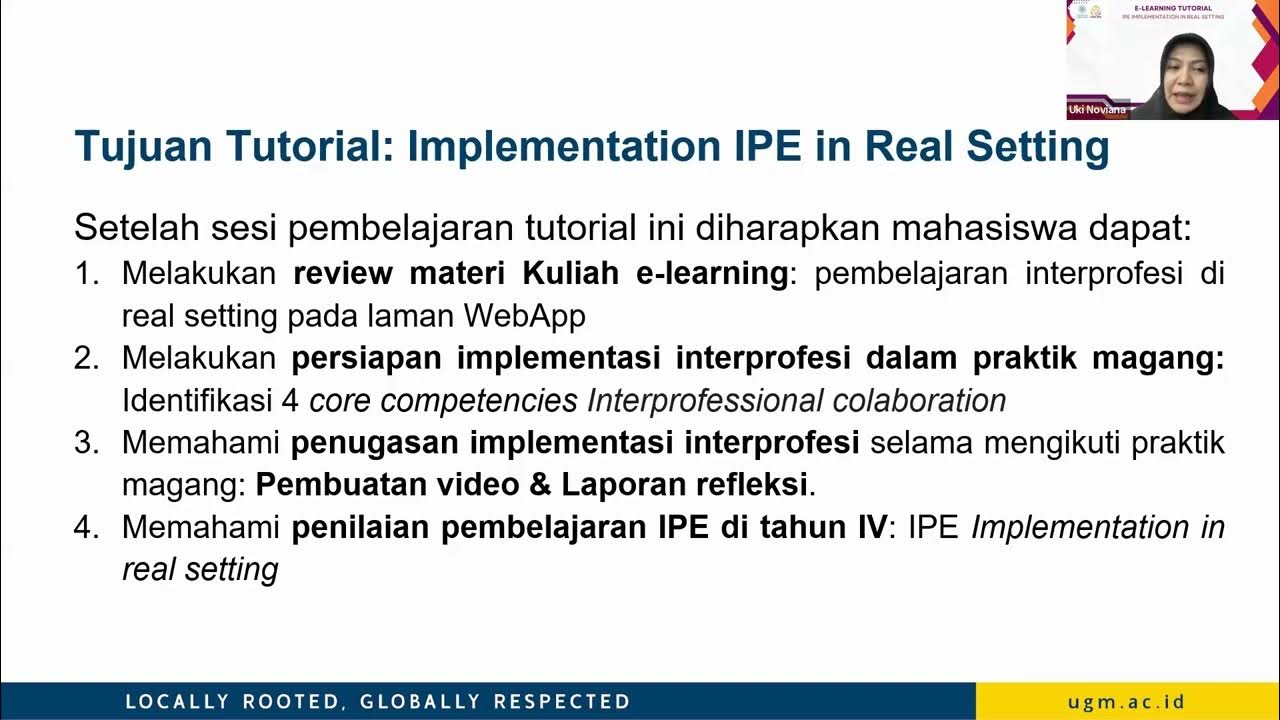VIDEO ROLE PLAY PENERAPAN IPE DAN IPC DALAM PELAYANAN KESEHATAN
Summary
TLDRThis video script showcases the vital role of Interprofessional Education (IPE) and Interprofessional Collaboration (IPC) in healthcare through a case study. It follows a patient, Mr. Galang, who seeks medical help for symptoms of diabetes mellitus. The healthcare team—including nurses, doctors, dietitians, and lab technicians—work together to diagnose and treat the patient. The script highlights the importance of clear communication, shared responsibilities, and coordinated decision-making, demonstrating how effective teamwork leads to optimal patient care. The video emphasizes the benefits of IPE and IPC, including better collaboration, improved outcomes, and enhanced patient experiences.
Takeaways
- 😀 Interprofessional Education (IPE) involves students from different healthcare professions learning together to collaborate in patient care.
- 😀 Interprofessional Collaboration (IPC) is the partnership between healthcare teams and patients for coordinated decision-making regarding health and social issues.
- 😀 IPE and IPC aim to enhance teamwork, communication, and decision-making within healthcare environments.
- 😀 The benefits of IPE and IPC include improved teamwork, better patient relationships, clearer roles and responsibilities, and enhanced ethical practices.
- 😀 In the case of Mr. Galang, the healthcare team needed to collaborate to determine the appropriate care and treatment plan for his diabetes diagnosis.
- 😀 Effective communication between healthcare professionals, including nurses, doctors, and dietitians, is crucial in providing holistic care to patients.
- 😀 The process of diagnosis and treatment involves multiple steps, from initial consultation to lab tests, and requires coordination among various healthcare providers.
- 😀 Diabetes mellitus diagnosis includes testing for glucose levels, with results influencing treatment plans and dietary adjustments.
- 😀 Dietitians play an essential role in guiding patients on proper nutrition and advising on foods to include or avoid for managing diabetes.
- 😀 The collaboration between various healthcare professionals ensures that a patient’s treatment plan is well-rounded, timely, and effective in managing chronic conditions like diabetes.
Q & A
What is the main theme of the video play presented by Group 3?
-The main theme of the video play is the implementation of Interprofessional Education (IPE) and Interprofessional Collaboration (IPC) in healthcare settings.
What are the key roles of the healthcare professionals involved in the case study?
-The key roles in the case study include a nurse, nutritionist, specialist doctor, general practitioner, laboratory staff, and the patient's family, each contributing to the diagnosis and treatment of the patient.
What does Interprofessional Education (IPE) refer to?
-Interprofessional Education (IPE) refers to a learning process where healthcare students or professionals from different disciplines learn together to enhance collaboration and teamwork.
What is Interprofessional Collaboration (IPC) in healthcare?
-Interprofessional Collaboration (IPC) refers to a partnership between healthcare providers and clients, where decisions regarding health and social care are made together in a coordinated manner.
Why is collaboration important in healthcare, as demonstrated in the case of Tuan Galang?
-Collaboration is crucial in healthcare because it allows professionals from different backgrounds to share their expertise and work together to provide comprehensive care, as seen in the coordinated efforts to diagnose and treat Tuan Galang.
What symptoms did Tuan Galang present with upon arrival at the hospital?
-Tuan Galang presented with symptoms such as fatigue, excessive thirst, frequent urination, and hunger, which were suggestive of diabetes mellitus.
What was the diagnosis made by the healthcare team regarding Tuan Galang?
-The healthcare team diagnosed Tuan Galang with diabetes mellitus, based on his symptoms and the results of laboratory tests.
What treatment was prescribed to Tuan Galang after his diagnosis?
-Tuan Galang was prescribed Metformin to lower glucose production from the liver, along with supplements and vitamins to prevent complications from diabetes.
How did the healthcare team coordinate their efforts in Tuan Galang's treatment?
-The healthcare team coordinated by involving the nurse, doctor, nutritionist, and laboratory staff. They collaborated to perform tests, prescribe medication, and provide dietary advice for effective management of diabetes.
What benefits are associated with Interprofessional Education and Collaboration, according to the script?
-The benefits include improved teamwork, better role understanding, enhanced communication, critical thinking, stronger relationships with patients, and the promotion of ethical practices in healthcare.
Outlines

This section is available to paid users only. Please upgrade to access this part.
Upgrade NowMindmap

This section is available to paid users only. Please upgrade to access this part.
Upgrade NowKeywords

This section is available to paid users only. Please upgrade to access this part.
Upgrade NowHighlights

This section is available to paid users only. Please upgrade to access this part.
Upgrade NowTranscripts

This section is available to paid users only. Please upgrade to access this part.
Upgrade NowBrowse More Related Video

Introduction to interprofessional collaboration and interprofessional education

What is interprofessional collaborative practice 1/7

E-learning Tutorial Asinkron Semester 7

IPE Core Competency Domain 2: Roles/Responsibilities

Collaboration Across Professions Improves Patient Outcomes

Ethical Interprofessional Collaboration
5.0 / 5 (0 votes)